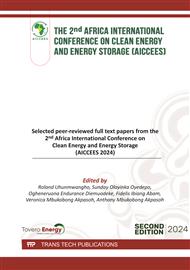[1]
W. Dadet, O. E. Ojong, K. K. Dagde, The design and energy simulation of CO2 capture process (CCP) for a liquefied natural gas (LNG) Plant, Advances in Science and Technology, 142 (2024) 181-192.
DOI: 10.4028/p-fd9c5r
Google Scholar
[2]
D.W. Breck, Zeolite Molecular Sieves, 172st ed., John Wiley & Sons, New York, 2018.
Google Scholar
[3]
D.M. Ruthven, Principles of Adsorption and Adsorption Processes, 1st ed., John Wiley & Sons, New York, 2012.
Google Scholar
[4]
M. Younas, M. Sohail, L.K. Leong, M.J.K. Bashir, S. Sumanthi, Feasibility of CO2 adsorption by solid adsorbents: a review on low-temperature systems, International Journal of Environment of Science and Technology, 13 (2016) 1839-1860.
DOI: 10.1007/s13762-016-1008-1
Google Scholar
[5]
K. Thambimuthu, M. Soltanieh, J.C. Abanades, Carbon dioxide Capture and Storage. Cambridge University Press, Cambridge, 2019, p.109.
Google Scholar
[6]
M. Kanniche, Pre-combustion, Post-combustion and Oxy-combustion in thermal power plant for CO capture, Applied Thermal Engineering, Elsevier, 30(1) (2021) 53.
DOI: 10.1016/j.applthermaleng.2009.05.005
Google Scholar
[7]
H. Yang, Z. Xu, M. Fan, R. Gupta, R.B. Slimane, A.E. Bland, I. Wright, Progress in carbon dioxide separation and capture, Journal of Environmental Science, 20(1) (2018) 14-27.
DOI: 10.1016/s1001-0742(08)60002-9
Google Scholar
[8]
Q. Wang, J. Luo, Z. Zhong, A. Borgna, CO2 capture by solid adsorbents and their applications: current status and new trends, Energy. Environmental Science, 4(1) (2021) 42–55.
DOI: 10.1039/c0ee00064g
Google Scholar
[9]
D. Bonenfant, M. Kharoune, P. Niquette, M. Mimeault, R. Hausler, Advances in principal factors influencing carbon dioxide adsorption on zeolites, Science Technology of Advance Material, 9 (2018) 7–13.
DOI: 10.1088/1468-6996/9/1/013007
Google Scholar
[10]
S. Montalvo, L. Guerrero, R. Borja, Application of natural zeolites in anaerobic digestion process, Applied Clay Science, 58 (1) (2021) 125-133.
DOI: 10.1016/j.clay.2012.01.013
Google Scholar
[11]
R. Triebe, Separation and Purification of Gases with Molecular Sieves, A Master Dissertation, University of Ottawa, 2017.
Google Scholar
[12]
A. Khelifa, L. Benchehida, Z. Derriche, Adsorption of carbon dioxide by X zeolites exchanged with Ni2+ and Cr3+: isotherms and isosteric heat, Journal of Colloid and Interface Science, 278(1) (2021) 9-17.
DOI: 10.1016/j.jcis.2004.05.033
Google Scholar
[13]
International Energy Agency(IEA), World Energy Outlook, Paris Cedex, France, 2016,pp.1-667.
Google Scholar
[14]
S. Afshin, Y. Rashtbari, M. Shirmardi, M. Vosoughi, A. Hamzehzadeh, Adsorption of basic violet 16 dye from aqueous solution onto mucilaginous seeds of Salvia sclarea: kinetics and isotherms studies, Desalination and Water Treatment 161 (2019) 365–375.
DOI: 10.5004/dwt.2019.24265
Google Scholar
[15]
R.S. Piriya, R.M. Jayabalakrishnan, M. Maheswari, K. Boomiraj, S. Oumabady, Coconut shell derived ZnCl2 activated carbon for malachite green dye removal, Water Science & Technology in press, 2021, pp.1-16
DOI: 10.2166/wst.2021.050
Google Scholar
[16]
J.A.C. Silva, Adsorption Equilibrium and Dynamics of Fixed Bed Adsorption of CH4/N2 in Binder-free Beads of 5A Zeolite, Industrial Engineering of Chemical Resource, 54 (2015) 6390−6399.
DOI: 10.1021/acs.iecr.0c01911.s001
Google Scholar
[17]
K. Schumann, B. Unger, A. Brandt, F. Scheffler, Investigation on the pore structure of binderless zeolite 13X shapes, Microporous Mesoporous Mater, 154 (2021)119-123.
DOI: 10.1016/j.micromeso.2011.07.015
Google Scholar
[18]
T.H. Ho, T. Howes, B.R. Bhandari, Encapsulation of gases in powder solid matrices and their applications, Powder Technology, 59 (2017) 87–108.
DOI: 10.1016/j.powtec.2014.03.054
Google Scholar
[19]
T.D. Pham, R. Xiong, S.I. Sandler, R.F. Lobo, Experimental and computational studies on the adsorption of CO2 and N2 on pure silica zeolites, Microporous Material, 185 (2018) 157–166.
DOI: 10.1016/j.micromeso.2013.10.030
Google Scholar
[20]
M.R. Hudson, W.L. Queen, J.A. Mason, D.W. Fickel, R.F. Lobo, C.M. Brown, Unconventional, highly selective CO2 adsorption in zeolite SSZ-13, Journal of American Chemical Society, 134 (2017) 1970–1973.
DOI: 10.1021/ja210580b
Google Scholar
[21]
K.K. Nair, King and Missionary in Efik politics (1846-1858), Journal of African Studies, 4 (3) (1977) 243-280.
Google Scholar
[22]
R. ed. Hallett, records of the African Association (1788-1831), New York: T. Nelson, London, 1964.
Google Scholar
[23]
E.U. Aye, The Efik people, Calabar, Glad Tidings press Ltd, 2000, ISBN 978-30541-3-9.
Google Scholar
[24]
W.F. Daniell, On the natives of old Callebar, West Coast of Africa, Journal of the Ethnological Society of London (1848-1856), 1 (1848) 210-227.
DOI: 10.2307/3014087
Google Scholar
[25]
L. Laskowski, M. Laskowska, N. Vila, M. Schabikowski, A. Walcarius, Mesoporous Silica-Based Materials for Electronics-Oriented Applications, Molecules, 24(13) (2019) 2395.
DOI: 10.3390/molecules24132395
Google Scholar
[26]
G.W. Beall, L.B. Hibbard, The thermal stability of calcium carbonate and its derivatives, Journal of Thermophysical and Heat Transfer, 19(4) (2005) 537-542.
Google Scholar
[27]
Y. Hu, H. Zhang, H. Wang, Thermal stability and structural transformation of clay minerals, Applied Clay Science, 123 (2016) 329-337.
DOI: 10.1016/j.clay.2016.08.016
Google Scholar


